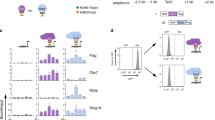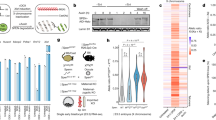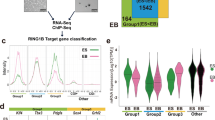Abstract
The Polycomb group (PcG) encodes an evolutionarily conserved set of chromatin-modifying proteins that are thought to maintain cellular transcriptional memory by stably silencing gene expression1. In mouse embryos that are mutated for the PcG protein Eed, X-chromosome inactivation (XCI) is not stably maintained in extra-embryonic tissues2. Eed is a component of a histone-methyltransferase complex that is thought to contribute to stable silencing in undifferentiated cells due to its enrichment on the inactive X-chromosome in cells of the early mouse embryo and in stem cells of the extra-embryonic trophectoderm lineage3,4,5,6,7,8. Here, we demonstrate that the inactive X-chromosome in Eed−/− trophoblast stem cells and in cells of the trophectoderm-derived extra-embryonic ectoderm in Eed−/− embryos remain transcriptionally silent, despite lacking the PcG-mediated histone modifications that normally characterize the facultative heterochromatin of the inactive X-chromosome. Whereas undifferentiated Eed−/− trophoblast stem cells maintained XCI, reactivation of the inactive X-chromosome occurred when these cells were differentiated. These results indicate that PcG complexes are not necessary to maintain transcriptional silencing of the inactive X-chromosome in undifferentiated stem cells. Instead, PcG proteins seem to propagate cellular memory by preventing transcriptional activation of facultative heterochromatin during differentiation.
This is a preview of subscription content, access via your institution
Access options
Subscribe to this journal
Receive 12 print issues and online access
$209.00 per year
only $17.42 per issue
Buy this article
- Purchase on Springer Link
- Instant access to full article PDF
Prices may be subject to local taxes which are calculated during checkout





Similar content being viewed by others
References
Ringrose, L. & Paro, R. Epigenetic regulation of cellular memory by the Polycomb and Trithorax group proteins. Annu. Rev. Genet. 38, 413–443 (2004).
Wang, J. et al. Imprinted X inactivation maintained by a mouse Polycomb group gene. Nature Genet. 28, 371–375 (2001).
Mak, W. et al. Mitotically stable association of polycomb group proteins Eed and Enx1 with the inactive X chromosome in trophoblast stem cells. Curr. Biol. 12, 1016–1020 (2002).
Silva, J. et al. Establishment of histone H3 methylation on the inactive X chromosome requires transient recruitment of Eed-Enx1 polycomb group complexes. Dev. Cell 4, 481–495 (2003).
Plath, K. et al. Role of histone H3 lysine 27 methylation in X inactivation. Science 300, 131–135 (2003).
Erhardt, S. et al. Consequences of the depletion of zygotic and embryonic enhancer of zeste 2 during preimplantation mouse development. Development 130, 4235–4248 (2003).
Okamoto, I., Otte, A. P., Allis, C. D., Reinberg, D. & Heard, E. Epigenetic dynamics of imprinted X inactivation during early mouse development. Science 303, 644–649 (2004).
Mak, W. et al. Reactivation of the paternal X chromosome in early mouse embryos. Science 303, 666–669 (2004).
Avner, P. & Heard, E. X-chromosome inactivation: counting, choice and initiation. Nature Rev. Genet. 2, 59–67 (2001).
Shumacher, A., Faust, C. & Magnuson, T. Positional cloning of a global regulator of anterior-posterior patterning in mice. Nature 383, 250–253 (1996).
Tanaka, S., Kunath, T., Hadjantonakis, A. K., Nagy, A. & Rossant, J. Promotion of trophoblast stem cell proliferation by FGF4. Science 282, 2072–2075 (1998).
Hadjantonakis, A. K., Gertsenstein, M., Ikawa, M., Okabe, M. & Nagy, A. Non-invasive sexing of preimplantation stage mammalian embryos. Nature Genet. 19, 220–222 (1998).
Strumpf, D. et al. Cdx2 is required for correct cell fate specification and differentiation of trophectoderm in the mouse blastocyst. Development 132, 2093–2102 (2005).
Levine, S. S., King, I. F. & Kingston, R. E. Division of labor in polycomb group repression. Trends Biochem. Sci. 29, 478–485 (2004).
Carrington, E. A. & Jones, R. S. The Drosophila Enhancer of zeste gene encodes a chromosomal protein: examination of wild-type and mutant protein distribution. Development 122, 4073–4083 (1996).
de Napoles, M. et al. Polycomb group proteins ring1A/B link ubiquitylation of histone H2A to heritable gene silencing and X inactivation. Dev. Cell 7, 663–676 (2004).
Wang, H. et al. Role of histone H2A ubiquitination in Polycomb silencing. Nature 431, 873–878 (2004).
Plath, K., Mlynarczyk-Evans, S., Nusinow, D. A. & Panning, B. Xist RNA and the mechanism of X chromosome inactivation. Annu. Rev. Genet. 36, 233–278 (2002).
Kohlmaier, A. et al. A chromosomal memory triggered by Xist regulates histone methylation in X inactivation. PLoS Biol. 2, E171 (2004).
Costanzi, C., Stein, P., Worrad, D. M., Schultz, R. M. & Pehrson, J. R. Histone macroH2A1 is concentrated in the inactive X chromosome of female preimplantation mouse embryos. Development 127, 2283–2289 (2000).
Huynh, K. D. & Lee, J. T. Inheritance of a pre-inactivated paternal X chromosome in early mouse embryos. Nature 426, 857–862 (2003).
Plath, K. et al. Developmentally regulated alterations in Polycomb repressive complex 1 proteins on the inactive X chromosome. J. Cell Biol. 167, 1025–1035 (2004).
Panning, B., Dausman, J. & Jaenisch, R. X chromosome inactivation is mediated by Xist RNA stabilization. Cell 90, 907–916 (1997).
Sheardown, S. A. et al. Stabilization of Xist RNA mediates initiation of X chromosome inactivation. Cell 91, 99–107 (1997).
Boggs, B. A. et al. Differentially methylated forms of histone H3 show unique association patterns with inactive human X chromosomes. Nature Genet. 30, 73–76 (2002).
Jeppesen, P. & Turner, B. M. The inactive X chromosome in female mammals is distinguished by a lack of histone H4 acetylation, a cytogenetic marker for gene expression. Cell 74, 281–289 (1993).
Boggs, B. A., Connors, B., Sobel, R. E., Chinault, A. C. & Allis, C. D. Reduced levels of histone H3 acetylation on the inactive X chromosome in human females. Chromosoma 105, 303–309 (1996).
Simon, J., Bornemann, D., Lunde, K. & Schwartz, C. The extra sex combs product contains WD40 repeats and its time of action implies a role distinct from other Polycomb group products. Mech. Dev. 53, 197–208 (1995).
Ng, J., Hart, C. M., Morgan, K. & Simon, J. A. A Drosophila ESC-E(Z) protein complex is distinct from other polycomb group complexes and contains covalently modified ESC. Mol. Cell. Biol. 20, 3069–3078 (2000).
Rinchik, E. M. & Carpenter, D. A. N-ethyl-N-nitrosourea-induced prenatally lethal mutations define at least two complementation groups within the embryonic ectoderm development (Eed) locus in mouse chromosome 7. Mamm. Genome 4, 349–353 (1993).
Acknowledgements
We are grateful to T. Jenuwein for sharing the anti-H3-3mK27 antibody; and to K. Worringer, S. Mlynarczyk-Evans and A. Anderson for supplying Xist, Hprt, Mecp2 and Pgk1 FISH templates and probes. We also acknowledge S. Mlynarczyk-Evnas for technical advice on FISH. S.K. is a recipient of an American Cancer Society postdoctoral fellowship. This work was funded by a National Institutes of Health grant to T.M.
Author information
Authors and Affiliations
Corresponding author
Ethics declarations
Competing interests
The authors declare no competing financial interests.
Supplementary information
Supplementary Information
Supplementary Figures S1, S2, S3 and S4 plus Supplementary Methods (PDF 899 kb)
Rights and permissions
About this article
Cite this article
Kalantry, S., Mills, K., Yee, D. et al. The Polycomb group protein Eed protects the inactive X-chromosome from differentiation-induced reactivation. Nat Cell Biol 8, 195–202 (2006). https://doi.org/10.1038/ncb1351
Received:
Accepted:
Published:
Issue Date:
DOI: https://doi.org/10.1038/ncb1351
This article is cited by
-
Quiescence enables unrestricted cell fate in naive embryonic stem cells
Nature Communications (2024)
-
Preventing erosion of X-chromosome inactivation in human embryonic stem cells
Nature Communications (2022)
-
Gene regulation in time and space during X-chromosome inactivation
Nature Reviews Molecular Cell Biology (2022)
-
Subcellular localization of EZH2 phosphorylated at T367 stratifies metaplastic breast carcinoma subtypes
Breast Cancer (2021)
-
PRC2 represses transcribed genes on the imprinted inactive X chromosome in mice
Genome Biology (2017)



